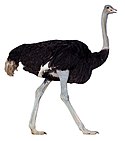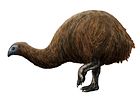Bush moa
| Bush moa Temporal range: Pleistocene-Holocene
| |
|---|---|

| |
| skeleton | |
| Scientific classification | |
| Domain: | Eukaryota |
| Kingdom: | Animalia |
| Phylum: | Chordata |
| Class: | Aves |
| Infraclass: | Palaeognathae |
| Order: | †Dinornithiformes |
| Family: | †Emeidae |
| Genus: | †Anomalopteryx Reichenbach 1852 |
| Species: | †A. didiformis
|
| Binomial name | |
| †Anomalopteryx didiformis | |
| Synonyms | |
| |
The bush moa, little bush moa, or lesser moa (Anomalopteryx didiformis) is an extinct species of moa from the family Emeidae (lesser moa) endemic to New Zealand.
Taxonomy
[edit]The bush moa was first scientifically described as Dinornis didiformis by R. Owen in 1844. He chose the specific name didiformis because of the apparent similarity in the shape and size of the bush moas' tarsometatarsus to that of the dodo (then Didus ineptus).[4]
Description
[edit]It was the smallest known species of moa,[5] only slightly taller than a turkey (approx. 1.3 metres (51 in) tall). A slender bird, it weighed around 30 kilograms (66 lb).[6] As with all moa, they have a sternum but no keel. They also have a distinctive palate.[7] It inhabited much of the North Island and small sections of the South Island of New Zealand. Its habitat was dense lowland conifer, broad-leafed southern beech forests and scrubland.[6][7] It possessed a sturdy, sharp-edged beak, suggesting that its diet was made up of twigs and other tough plant material.[5] Bush moa coprolites indicate ferns were a crucial food source for them.[8]
Threats and extinction
[edit]Native predators included the Haast's eagle and Eyles' harrier.[6] The species went extinct alongside other native New Zealand wildlife around 500-600 years ago, following the arrival and proliferation of the Māori people in New Zealand (who called them "moariki"),[1] as well as the introduction of Polynesian dogs.[6]
Archaeological remains
[edit]
The most complete remains, a partially articulated skeleton with substantial mummified tissue and feathers were discovered in 1980 in Lake Echo Valley, east of Te Anau, Southland.[9] It is now in the Southland Museum and Art Gallery, in Invercargill. Anomalopteryx fossils made up the bulk of moa fossils discovered in a swamp in 1912 in Clevedon.[10]
Possible de-extinction
[edit]Scientists at Harvard University assembled the first nearly complete genome of the species from toe bones,[11][12] thus bringing the species a step closer to being "resurrected" in the future, likely by using the emu as a proxy.[11]
References
[edit]- ^ a b "Anomalopteryx didiformis". NZTCS (nztcs.org.nz). Retrieved 29 April 2023.
- ^ Brands, Sheila (14 August 2008). "Classification genus Anomalopteryx". The Taxonomicon Project (taxonomy.nl). Systema Naturae 2000. Retrieved 4 February 2009. [permanent dead link]
- ^ Gill, B.J.; Bell, B.D.; Chambers, G.K.; Medway, D.G.; Palma, R.L.; Scofield, R.P.; et al. (2010). Checklist of the birds of New Zealand, Norfolk, and Macquarie Islands, and the Ross Dependency, Antarctica (PDF) (4th ed.). Wellington, NZ: Te Papa Press. ISBN 978-1-877385-59-9.
- ^ Owen, Richard (1844). "On Dinornis, an extinct genus of tridactyle struthious birds, with descriptions of portions of the skeleton of five species which formerly existed in New Zealand". Transactions of the Zoological Society of London. 3: 235–275. Retrieved 28 July 2023.
- ^ a b Tennyson, Alan J.D. (2006). Extinct Birds of New Zealand. Martinson, Paul (illustrator). Wellington, NZ: Te Papa Press. p. 32. ISBN 978-0-909010-21-8. OCLC 80016906.
- ^ a b c d "Little bush moa". New Zealand birds online (nzbirdsonline.org.nz). Retrieved 19 February 2021.
- ^ a b Davies, S.J.J.F. (2003). "Moas". In Hutchins, Michael (ed.). Grzimek's Animal Life Encyclopedia. Vol. 8 – Birds I – Tinamous and Ratites to Hoatzins (2nd ed.). Farmington Hills, MI: Gale Group. pp. 95–98. ISBN 0-7876-5784-0.
- ^ Wood, Jamie R.; Vermeulen, Melanie J.; Bolstridge, Nicola; Briden, Shar; Cole, Theresa L.; Rivera-Perez, Jessica; et al. (July 2021). "Mid-Holocene coprolites from southern New Zealand provide new insights into the diet and ecology of the extinct little bush moa (Anomalopteryx didiformis)". Quaternary Science Reviews. 263: 106992. Bibcode:2021QSRv..26306992W. doi:10.1016/j.quascirev.2021.106992. Retrieved 23 April 2024 – via Elsevier Science Direct.
- ^ Forrest, R.M. (1987). "A partially mummified skeleton of Anomalopteryx didiformis from Southland". Journal of the Royal Society of New Zealand. 17 (4): 399–408. Bibcode:1987JRSNZ..17..399F. doi:10.1080/03036758.1987.10426481. Retrieved 8 July 2015 – via Google books.
- ^ Gill, B. J. (2003). "Historical Moa Bone Collections (Aves: Dinornithiformes) at Auckland Museum — Clevedon and Kia Ora". Records of the Auckland Museum. 40: 39–53. ISSN 1174-9202. JSTOR 42905862. Wikidata Q58623335.
- ^ a b "Scientists reconstruct the genome of a moa, a bird extinct for 700 years". STAT News. 27 February 2018. Retrieved 20 February 2021.
- ^ "Anomalopteryx didiformis". Genome. U.S. National Center for Biotechnology Information. U.S. National Institutes of Health. ID 124.
External links
[edit]- Martinson, Paul (2005). Little bush moa Anomalopteryx didiformis (watercolour).
Artwork produced for Tennyson (2006), p. 32




